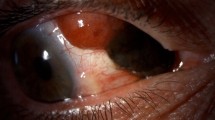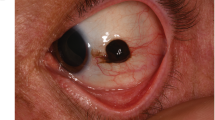Abstract
Twenty-six patients (age 29-85 years) with primary malignant melanoma of the conjunctiva were analysed for usefulness of various histopathological and immunohistochemical features of the primary, recurrent and metastatic tumours in evaluating their prognosis. The mean follow-up time was 5.5 years, ranging from 8 months to 17 years. Eight patients developed metastases and seven have died. The mean time from diagnosis to death due to metastasis was 3.8 years (range 1-6 years). The site of the primary tumour seemed to be most closely correlated to high metastatic risk. Only two of the sixteen limbal melanomas metastasised, whereas two of the four bulbar, all three tarsal and the only diffuse primary tumour caused metastatic disease. Two of the metastasising primary tumours were less than 1.5 mm thick, but all exceeded 0.8 mm in thickness. The mitotic rate, the amount of inflammatory infiltrate, the cell type or the presence of adjacent intraepithelial involvement did not obviously correlate to treatment outcome. Furthermore, the expression of S-100 protein and neuron-specific enolase (NSE), both suggested to be prognostic indicators in cutaneous melanoma, did not correlate to the tendency of the conjunctival melanomas to recur or metastasise.
Similar content being viewed by others
Author information
Authors and Affiliations
Rights and permissions
About this article
Cite this article
Fuchs, U., Kivelä, T., Liesto, K. et al. Prognosis of conjunctival melanomas in relation to histopathological features. Br J Cancer 59, 261–267 (1989). https://doi.org/10.1038/bjc.1989.55
Issue Date:
DOI: https://doi.org/10.1038/bjc.1989.55
- Springer Nature Limited
This article is cited by
-
Proton radiotherapy in advanced malignant melanoma of the conjunctiva
Graefe's Archive for Clinical and Experimental Ophthalmology (2019)
-
Proton radiotherapy as an alternative to exenteration in the management of extended conjunctival melanoma
Graefe's Archive for Clinical and Experimental Ophthalmology (2006)
-
Rare variants of malignant melanoma
World Journal of Surgery (1992)




